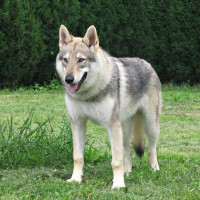 |
Lupo Italiano |
|
He is not recognized by the F.C.I. |
Origin |
Italy | |
Translation |
Francis Vandersteen |
| The story of the Italian wolf began in 1966, with a puppy born of a cross between a German shepherd and a wild wolf from the Apennines of Upper Lazio. The specimen, named Zorro, can be considered the ancestor of the Italian wolf breed. Subsequently, thanks to severe genetic programming, the intermediate characteristics were permanently fixed and passed on consistently and homogeneously over a period of thirty years. In the case of a breed such as this, born of significant genetic contributions from the wolf, it is essential that, in addition to morphological identity, there is a balance in the psychic characteristics obtained and, above all, that there is compatibility with man. The Italian Lupo, a protected breed whose commercialization and reproduction outside the protection organization is forbidden, is bred on a non-profit basis by the Italian Wolf Protection Agency (ETLI - President Mario Messi) and is entrusted free of charge to entities, associations and individuals who undertake to use it only for civil protection or in all cases of public interest. The State Forestry Corps mainly uses this dog, although some foresters still use the German Shepherd. The Italian wolf is always safe and reliable when accompanying forest patrols. It has a very strong attitude to rescue tasks in avalanche situations, under rubble and in particular to the search for missing people and even animals. There are just over 500 specimens in existence. Italian Wolfdogs are robust, resistant to fatigue and possess considerable sensory acuity: qualities that, along with their outward appearance, bring them close to wolves. Overflowing with vivacity, with a proud, independent character, they obey out of conviction, never out of servility. He is very affectionate with the people he lives with, to whom he attaches himself exclusively; he distrusts strangers and has a strong sense of ownership and defense of the people entrusted to him. Its strength and staying power are extraordinary. The breed's characteristics of originality, homogeneity, constancy and balance at genetic, morphological and psychological levels make it an exemplary case in the history of breeds and in the relationship between man and the environment. Males measure 60 to 70 cm at the withers, females 58 to 65 cm. The trunk is robust, not too long, the thorax well let down, well built, forming a sinuous profile and particularly harmonious between the lines of the throat, chest, sternum and belly, recto-lumbar line straight, croup not too low. The head and muzzle are lean and well shaped, with a typical wolf face, slightly refined towards the tip, strong jaw and teeth. Black nose. Strong, very white, scissor-like teeth. Medium-sized ears, very pristine and perfectly parallel when alert, very mobile according to the animal's moods and movements. Medium-sized eyes, rather oblique, not protruding, never too dark, preferably with a golden background, intense and loyal expression. Limbs perfectly set, very strong but lean, must not give the impression of excessive heaviness, hindquarters not too sloping. Tail rather long and well furnished, but without exaggeration, kept low and hanging at rest, it rises with a harmonious and not excessive curve when the animal is agitated, without its main axis ever reaching the vertical, it must be carried with elegance and freedom. With a loose, light gait, the animal, even at maximum size and weight, must be able to give an impression of elegant strength for the walk, trot and gallop, which is tight and fast, reminiscent of the gait of the wild wolf, which characterizes the aligned position of the footprints when the trot is fast with the oval foot. The whole trunk and limbs emphasize the fluidity and power of the joints and insertions, with highly functional results in shoulder and hip movements. Hair of medium length and hardness, smooth or rather rough, limited to trunk and thighs, finer and shorter on head and legs, with thick undercoat in outdoor subjects. Color gray, marked variation, more or less dark with the background in different shades from subject to subject up to fawn or beige, also with black saddle, well-defined strawberry, belly, limbs, especially in the lower part, on the inside and back of the lighter thighs, gray or rusty gray, light fawn or beige; in each coat type, a small white patch on the chest is permitted according to seasonal variations. |






 English (United Kingdom)
English (United Kingdom)